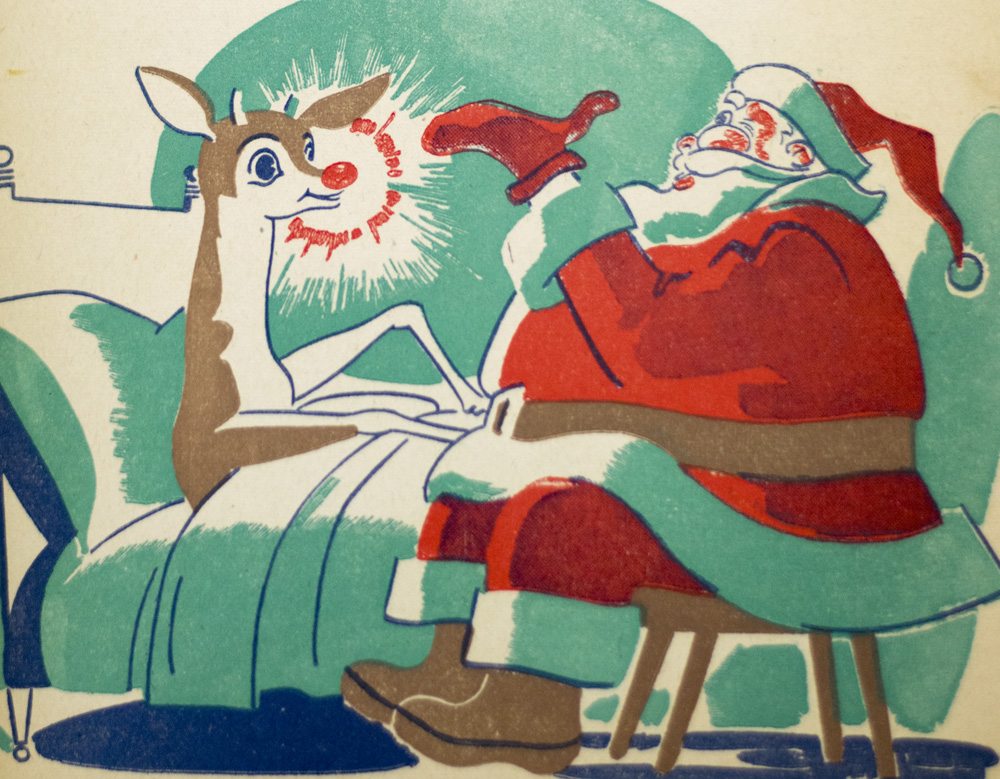My Sunshine
When you are my sunshine
Soaked in winter woes
Struggling to peer at
My checkered countenance
Waiting for you in towers of silence
Shadows slink away in terror
For they know you are my life force
The harbinger of my jolly Rudolf
The Santa Claus of my icy wants
My apple cider mulled with spices
The cinnamon to my cloves

Rudolph the Red-Nosed Reindeer and Santa Claus -- Denver Gillen
Robert L. May was a low-paid in-house advertising copywriter for the mail order pioneer Montgomery Ward, the largest retailer in the US, at the store’s Chicago flagship. The corporation had been giving away promotional coloring books for Christmas every year, but in 1939 it decided to produce its own book to save money and assigned the task to May. “‘Twas the Night Before Christmas,” the most popular and influential literary work in establishing the modern characteristics of Santa Claus, had been published anonymously in 1823 as “A Visit from St. Nicholas.” The poem was written in anapestic tetrameter (four feet, unstressed, unstressed, stressed), the same structure used in limericks. May adapted the familiar meter for his own poem-booklet, “Rudolph the Red-Nosed Reindeer,” a tale about a reindeer who was scorned by his fellows due to his odd looks, which then were the cause of his redemption. The promotional book included 41 illustrations by Denver Gillen, and 2.4 million copies were distributed that holiday season, but wartime restrictions on paper use prevented a re-issue until 1946. World War II also had an impact on the career of Max Fleischer, the pioneer animator behind the cartoon versions of Betty Boop, Popeye, and Superman, failed to form a new studio to meet the demand for military training films, so he took a job as head of the animation department for the industrial film company, The Jam Handy Organization in Detroit, Michigan. In 1944 he adapted the May book as a cartoon short sponsored by Montgomery Ward. In 1946 Montgomery Ward was able to reprint the booklet and distributed another 3.6 million copies, and the corporation president .Sewell Avery granted the copyright rights to May, who licensed a successful spoken-word record of the poem. In 1947 Maxton Publishers, a small New York firm, produced an updated print edition of the poem, which was a best-seller despite the prevailing wisdom that the distribution of millions of free copies had ruined the market. That year his sister married Johnny Marks, who wrote a song based on the poem in 1947. Major vocalists such as Bing Crosby and Dinah Shore declined to sing the song, but singing cowboy Gene Autry’s wife persuaded him to use it as the B-side of another record. It was released in 1949 and went to #1 on the sales charts (1.75 million copies the 1st year, 12.5 million over time); including cover versions, it has sold over 12.5 million records, more than any other Christmas song except Irving Berlin’s "White Christmas." (Crosby was responsible for the success of the Berlin song, and his 1950 version of “Rudolph” also charted.)
ReplyDeleteRudolph the Red-Nosed Reindeer
Had a very shiny nose
And if you ever saw it
You would even say it glows
All of the other reindeer
Used to laugh and call him names
They never let poor Rudolph
Join in any reindeer games
Then one foggy Christmas Eve
Santa came to say
"Rudolph, with your nose so bright
Won't you guide my sleigh tonight?"
Then how the reindeer loved him
As they shouted out with glee
"Rudolph the Red-Nosed Reindeer
You'll go down in history."
Though both men were Jews, May and Marks continued to contribute to American Christmas traditions. In 1947 May wrote a prose version of “Rudolph” (though the title character spoke in anapestic tetrameter), but it was not published until 1992 as “Rudolph's Second Christmas.” In 1954 he wrote another sequel in anapaestic tetrameter (“Rudolph Shines Again”). In 1958 Brenda Lee recorded Marks’ "Rockin' Around the Christmas Tree" (Decca released it again in 1959, but it did not become a success until its 1960 release and eventually sold over 25 million); in 1962 he wrote “A Holly Jolly Christmas,” which Burl Ives sang for an animated Christmas TV special in 1964 and rerecorded in its familiar arrangement in 1965; and in 1958 Chuck Berry recorded "Run, Rudolph, Run," written by Marks and Marvin Brodie.